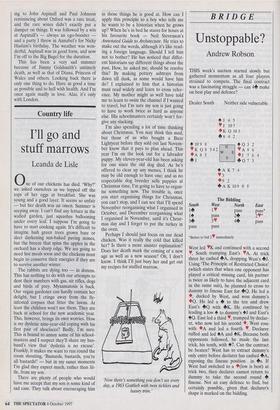BRIDGE
Unstoppable?
Andrew Robson
THIS week's auction started slowly but gathered momentum as all four players strained to compete. The final contract was a fascinating struggle — can 4+ make on best play and defence?
Dealer South Neither side vulnerable J 6 5 J 107 • K 0 10 3 +6 4 2 4 10 9 K 0 • A 8 J 8 8 5 542 4 0 3 VA 9 • J7 + Q 7 2 6 64 3
W E
4 A K 7 4 le 3 • 9 2 + A K 109 8 5 South 1+ 3+ pass The Bidding West North East 1, pass pass* pass 2+ 2V* 3V 4+ pass pass *Better to bid 21, immediately West led Ilk and continued with a second V, South trumping East's VA. At trick three he cashed 4A, dropping West's +J. Using 'The Principle of Restricted Choice' (which states that when one opponent has played a critical missing card, his partner is twice as likely to have the adjacent card in the same suit), he planned to cross to dummy to finesse East for +Q. He led a 4, ducked by West, and won dummy's • Q. He led a + to the ten and drew East's +Q with +K. He continued by leading a low 4 to dummy's 4J and East's 4Q. East led a third V. trumped by declar- er, who now led his second 4. West rose with •A and led a fourth V. Declarer ruffed and led 4A and 4K. Because both opponents followed, he made the last trick, his tenth, with 47. Can the contract be beaten? West has to extract dummy's only entry before declarer has cashed +A, exposing the finesse position in 4s. If West had switched to a 4(low is best) at trick two, then declarer cannot return to dummy to take the second round finesse. Not an easy defence to find, but certainly possible, given that declarer's shape is marked on the bidding.










































































 Previous page
Previous page